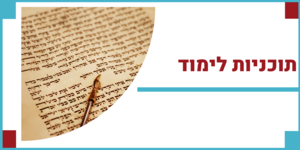
בס''ד
בעל שם טוב פרשת צו
Last year we learned masechet Hagiga in night seder. On the first night of class I introduced the material; we will be learning about the obligations that accompany an appearance in the Temple.
The students couldn’t hide their disappointment. “We expected something meaningful. This is supposed to be relevant to our lives?”
We began by reading the first Mishna which rules that women are excluded from the obligations in any case. Disappointment hardened into open rebellion, “for two nights a week, for the rest of the year, you expect us to study animal sacrifice and impurity laws that haven’t been kept in 2000 years, and even when they were, excluded us?!
I closed my Gemara, found a copy of masechet Megilla on the shelf behind me, and read the following lines (loosely translated),
G-d promised Abraham that His commitment to his children would never be shaken. The guarantee, He explained, was that the Temple sacrifices would ensure atonement for any sins that otherwise threatened the covenant. “But”, Abraham asked, “what happens if the Temple is destroyed? What will atone for my children’s sins then?”
G-d replied, “I have recorded the commandments relating to the sacrifices. When they learn them, it will be as if they have fulfilled them”. (source ב below)
Study, the Talmud asserts, activates the latent redemptive power of a mitzvah, even when the commandment cannot be fulfilled in practice. When gates to performance are blocked (by historical or by halachic restrictions), the inner resources of the commandments remain accessible to anyone who can learn them.
And so, I pointed out, paradoxically the fact that the commandment is inaccessible today opens its gates equally to men and women… providing that women learn how to learn, which is what you are about to do.
The Gemara, I added, consists of a rich, seemingly endless discussion of ideas, laws, customs, stories and opinions. Each Talmudic chapter, while shaped around concrete halachic questions, explores the underlying existential, theological and philosophical issues related to that law. In the case of Hagiga the Talmud’s primary question is the possibility and character of an encounter with G-d: in the language of the Torah, “seeing” G-d and “being seen”.
I believe that those ideas are quite relevant to your religious lives, and my sense is that learning masechet Hagiga this year will change you, and transform how you approach G-d for the rest of your life.
Many of those ideas, even the most profound and foundational, were fully articulated only after the Temple was destroyed. So not only is the commandment to offer sacrifices in not only accessible through the learning, but at least on one level, the commandments as you encounter them in your learning are richer than they were two millennia ago. And we began masechet Hagiga a second time, with a slightly different set of goals in mind.
In his teaching below (source א), the Besht develops the idea that the act of Torah learning can tap into the power of fulfilling the command, and that Torah learning impacts the Torah no less than it impacts the person.
The Besht
Rabbinic Judaism has always recognized multiple levels of meaning in any single Biblical text. In that sense educated observant Jews are never strictly “fundamentalist”. No holy text has only one single fundamental meaning.
According to the Besht (paragraph 1 of source א below), this means that every text has “מוחין”, a subterranean and undifferentiated meaning that can be made manifest in many ways and on many levels, but that can never be exhausted. Similar to the relationship between a person’s soul and their person, the text’s potential מוחין will always remain greater than any manifestation. Each time one discovers a new insight into the text one reveals a little more of its מוחין, coaxing it from behind the masks that have hidden it until now.
The relationship between the reader and the text goes both ways.
We have all had the experience of reading a simple text. And then, after hearing a brilliant reading, returning to the same words only to realize just how extraordinary they were all along. The “חידוש”, the “new” insight, was always there, but was hidden and inaccessible. Now the text itself has grown for us, it is a greater thing now than it was. Retroactively we realize that the Torah has always encompassed the חידוש. The insight was merely awaiting the creative scholar who could reveal it.
The Besht goes further (paragraph 2). Not only does each new interpretation give deeper life to a text, but the emotional relationship of the scholar to the text does as well. The awe and love for what we are learning, the relationship with G-d that underlies our engagement with the text; that too adds to the מוחין of the text we love and study.
A former student once told me that one year into college, she had forgotten much of what she learned in midresha. What she hadn’t forgotten, though, was the enthusiasm with which her teachers taught her; as she put it, “how they turned the page of the Gemara.” She saw love and awe for the text they were teaching, and that impression stayed with her, even after her memories of the text itself proved slippery.
Shlomo Carlebach once pointed out on leil Simchat Torah that he had never seen an English professor dance with a copy of Hamlet. There is something about the love and awe we feel for the Torah that changes both it and us, enables it to grow in our eyes and in the eyes of everyone who encounters it through us.
The Besht (3) concludes his teaching with the observation that while the learning of a text can make manifest deeper, hidden layers of a commandment, still it remains true that the physical experience of observing a mitzvah manifests the commandment in a way that study never can: in the world of actions.
Observance and Torah study complete one another. We need both. And so does the Torah.
Shabbat shalom, Rav Yehoshua
(R Gedaliah Fleer helped me understand the implications of the kabalistic terminology of this teaching. I can’t blame him if I got it wrong, but I can thank him for whatever I got right)
In source ג below, the Sfat emet applies the Besht’s idea (that the telling of a story can uncover layers of Truth that were not accessible to those who experienced the original events) to the commandment to tell the story of the Exodus on Pessach. He teaches that by telling the story of the Exodus, each of us (potentially)reveals and activates a new aspect of the forces of redemption contained in the original story, bringing the world closer to its own redemption.
א. ספר בעל שם טוב ויקרא פרשת צו, א (ליקוטי אמרים דף ג' ע"ג, והוא בקיצור בכתר שם טוב ח"ב דף ג' ע"ב)3.
איתא כל העוסק בתורת עולה כאילו הקריב עולה (מנחות ק"י א), כשאדם מחדש איזה דבר חכמה בתורה הוא נותן מוחין באותן הדיבורים, מפני שהיו המוחין בתחילה בהעלם מלובשים באותן הדיבורים, ועכשיו הוא מפשיט אותם מהלבוש, ומתגלים ומתגדלים, וזהו קישוטי כלה,
וכן כשהוא מדבר דברי תורה בדחילו ורחימו, הוא נותן מוחין באלו הדיבורים, ולכן כל העוסק בתורת עולה כאילו הקריב עולה, מפני שכאשר הוא מדבק באותן הדיבורים ביראה ובאהבה, אז הוא נותן חיות חדש באלו הדיבורים, אף על פי שנתקלקלו מחמת חטאים, אף על פי כן הם לבושין דמלכא,
אבל כשהיה בית המקדש קיים והיה מקריב קרבן עולה, היה נותן כח אף בעולם המעשה: ajor-bidi'>1. איתא כל העוסק בתורת עולה כאילו הקריב עולה (מנחות ק"י א), כשאדם מחדש איזה דבר חכמה בתורה הוא נותן מוחין באותן הדיבורים, מפני שהיו המוחין בתחילה בהעלם מלובשים באותן הדיבורים, ועכשיו הוא מפשיט אותם מהלבוש, ומתגלים ומתגדלים, וזהו קישוטי כלה,
ב. תלמוד בבלי מסכת מגילה דף לא עמוד ב
אמר רבי אמי: אלמלא מעמדות לא נתקיימו שמים וארץ, שנאמר אם לא בריתי יומם ולילה חקות שמים וארץ לא שמתי, וכתיב ויאמר ה' אלהים במה אדע כי אירשנה, אמר אברהם לפני הקדוש ברוך הוא: רבונו של עולם! שמא חס ושלום ישראל חוטאים לפניך ואתה עושה להם כדור המבול וכדור הפלגה? – אמר לו: לאו. – אמר לפניו: רבונו של עולם, במה אדע? – אמר לו: קחה לי עגלה משלשת וגו'. – אמר לפניו: רבונו של עולם, תינח בזמן שבית המקדש קיים, בזמן שאין בית המקדש קיים מה תהא עליהם? – אמר לו: כבר תקנתי להם סדר קרבנות, כל זמן שקוראין בהן מעלה אני עליהן כאילו מקריבין לפני קרבן, ומוחל אני על כל עונותיהם.
ג. שפת אמת פסח שנה תרלה
ואפילו כולנו חכמים כו'. עפ"י מ"ש כמה מעלות טובות כו'. פי' שהביאנו מדריגה אחר מדריגה עד שקבלנו התורה והכניסנו לארץ ישראל. אעפ"כ כל אלו המעלות דביקין האחרונה בראשונה. לכן כמה טובה כפולה ומכופלת שהם חוזרין מלמטה למעלה ג"כ. ואף שכולנו חכמים כו' אעפ"כ נס הראשון מיצ"מ נוהג בנו.
וכל המרבה לספר ביציאת מצרים הרי זה משובח. שהסיפור ביציאת מצרים מביא דעת כמ"ש ולמען תספר באזני בנך כו'. וידעתם כי אני ה'. ומאחר שיציאת מצרים נאמרה בתורה והתורה ניתנה לישראל יכולין לעורר כח הגאולה כי יציאת מצרים יוצא מכח אל הפועל ע"י הסיפור. כמו ענין תורה שבכתב ושבע"פ שבנ"י מחדשין טעמי תורה. וזה כחן בפה שע"י שמוציאין הדברים בפה מגלין הטעמים הנסתרים לבוא לידי גילוי.
וכמו כן תנאים אלו שדרשו שכל מכה הי' של ד' וה' מכות ושנלקה ר"נ מכות הכל הוציאו מכח המכות. שהי' נסתר אלה המכות והם הוציאו מכח אל הפועל. וזה פי' מרבה לספר ביציאת מצרים שמרבין ומתפשטין הנסים והמכות ע"י סיפורים ביצ"מ כנ"ל. וגם גאולה האחרונה תהי' כשיתברר כל הנסתרות שביציאת מצרים כי גאולה זו כוללת כל הגאולות.
וז"ש להביא לימות המשיח כי זכירה וסיפור ביציאת מצרים מביא ימות המשיח. כי בעת יציאת מצרים הי' הרצון להיות תיקון הכולל כמו שיהי' לעתיד ה' ושמו אחד. אך כי עמלק הרשע בלבל את בנ"י כמ"ש אשר קרך בדרך. ולכן צריכין לזכור שנאתו לעולם. כי הוא גרם לנו כל הגלות. רק ע"י סיפור ביציאת מצרים בכל שנה ושנה נתעורר התיקון. ונמחה שמו מעט מעט. לכן נקרא מעשה לילה זו סדר כי צריכין לחזור ולסדר מעשה יציאת מצרים להיות מתוקן ומסודר ואז יהי' הגאולה בב"א:
שיעורים נוספים ניתן למצוא בקטגוריות הבאות: חסידות
| תאריך העלאה: | כ״א באדר ב׳ ה׳תשע״ו |
| 31/03/16 |









